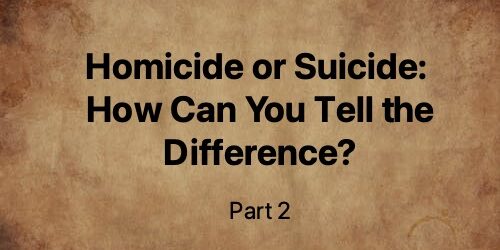Distinguishing Between a Staged Suicide (Homicide) or an Actual Suicide Is Crucial in a Death Investigation
Our previous blog discussed how investigators can distinguish the difference between a homicide and an accidental death. When it comes to determining whether a person’s death was either a suicide or homicide, there can be several indications to distinguish the two – if the scene is appropriately and thoroughly investigated.
The Staging of the Scene
When investigators take a look at the crime scene, several different aspects are looked at. The body’s position, placement of the weapon, forensics, and anything that seems out of the ordinary are all considered. Other indications at the scene, such as blood spatter patterns, the gunshot wound’s trajectory, and even signs of a struggle or defensive wounds, explain whether the scene was staged to appear as a suicide.
In a suicide case, the scene will not often show any indication of a person in the middle of a routine such as doing laundry, cooking, or cleaning. Suicides and homicides are almost always premeditated, but the difference between the two is whether it was premeditated by the deceased (suicide) or by another person (homicide).
The Underlying Cause of Death
In addition to investigating the scene of the person’s death, looking into the exact injuries that caused the person’s death can indicate whether the death should be ruled a suicide or homicide. This is a crucial step that is often overlooked. Law enforcement may conclude that the scene does not indicate foul play, but just because homicide does not look apparent, a closer look can make a significant difference in the case.

There have been several instances where a person’s death had been staged to appear as though they took their own life through hanging. However, after closer examination, pathologists may find that the victim has injuries that indicate manual strangulation or even a broken neck (a rare injury in a suicide). In a suicide case, a hanging would indicate the person died by suffocation, not strangulation.
In a potential suicide case, it is always important to request a medical expert to determine if the person’s death was self-inflicted or carried out by another person or people.
Suicide Note
In a death investigation regarding a potential suicide, the note left behind can provide several clues regarding motive. Were there internal or external forces that pushed someone to take their own life? Or does the message sound as though it was written in spite? How the note is written can also indicate whether the victim wrote the letter by choice or by coercion. These are several questions to consider to determine whether the person’s death was a suicide or staged to appear as such.
If there is no note left behind or is not handwritten, red flags are often raised. This is not a conclusive reason to rule a person’s death a homicide rather than a suicide, but it does raise questions.
The Moments Prior to the Incident Can Provide Insight into Possible Motive
When investigating an alleged suicide, statements from friends and family members can provide great insight into the person’s death. Did the victim seem distracted or worried about something before their death? Had the victim made recent changes to their will or started giving away their possessions? Was the victim experiencing marital/relationship or financial problems? History of drinking or drug use?
Any insights into the person’s life can help investigators piece together the motive behind their death. In suicide cases, the motive is generally an internal feeling where the person feels as though they had no other options. In a homicide, there are several motives: revenge, money, love, jealousy, etc. The key way to distinguish between a suicide motive and a homicide motive is to determine if the death scene, cause of death, and all other factors match the motive of either.
Speak to a Death Investigator Regarding Your Case
One of the most common mistakes is quickly ruling a person’s death a suicide before a thorough investigation. This commonly happens when an inexperienced patrol officer investigates the scene or when law enforcement rushes to close a case. Even if a loved one’s death was ruled a suicide, having a death investigator take a second look can help you get the answers you need for closure and justice.








